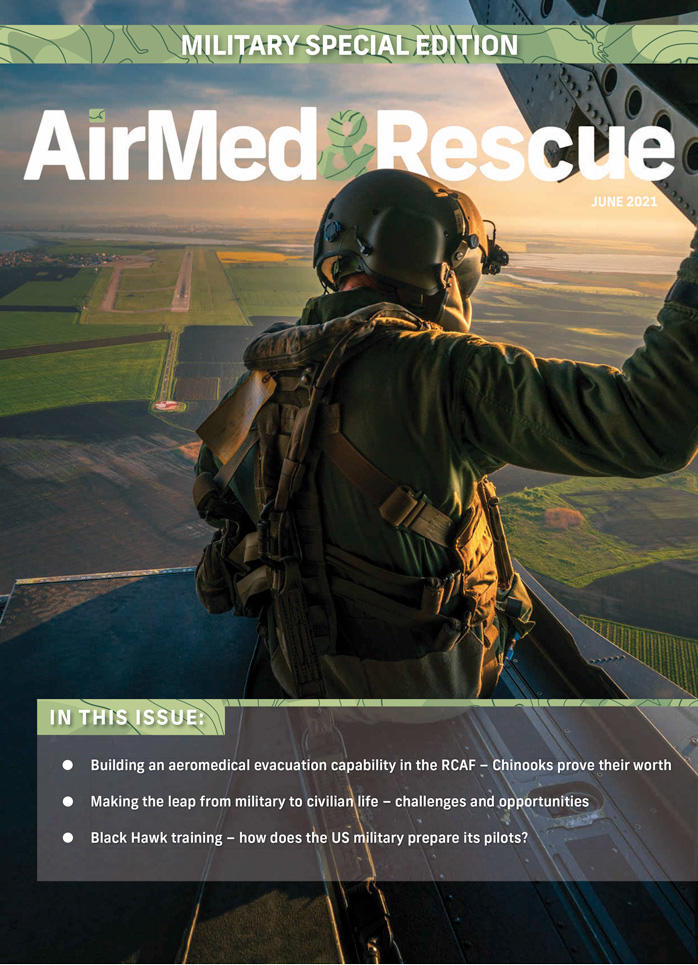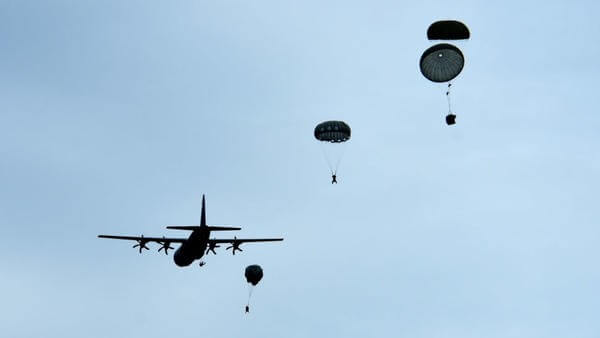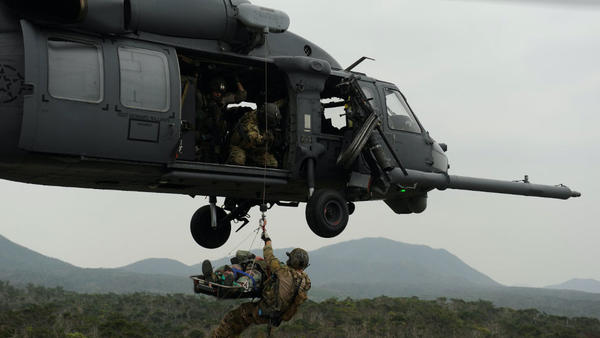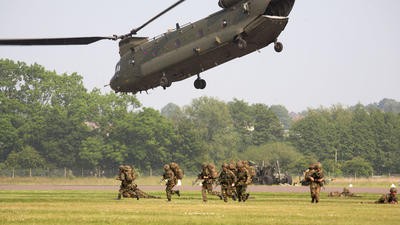A vocation as a US Air Force PJ

Mandy Langfield spoke to Chief Master Sgt Travis Shaw of the US Air Force about his role as Pararescue Functional Manager at Headquarters US Air Forces in Europe and Air Forces Africa, as well as how he sees the role of the PJ changing in the future
Could you share a brief overview of your Air Force career, just so we can have an idea of how you came to be manager of the USAF pararescue unit in Italy?
I joined the Air Force as a weapon maintainer in 1999, but after a few years of wrenching warheads I knew I had a different calling. I retrained into Pararescue (PJs) five years later, and have enjoyed assignments in the US and overseas. I’ve spent time at operational rescue squadrons and at headquarters locations, more recently managing our medical protocols, equipment and training programs. Putting all the prior tactical and operational tools together, I currently sit as the Pararescue Functional Manager at Headquarters US Air Forces in Europe and Air Forces Africa (USAFE-AFAFRICA), Ramstein AB, Germany. From here, I manage pararescue’s efforts on the European and African continents, both with starkly unique rescue challenges. I am also a member of the Committee on Tactical Combat Casualty Care (CoTCCC), helping manage the US military’s battlefield trauma protocols.
How does it work, being based in Germany but managing the team in Italy?
The Germany location of USAFE-AFAFRICA Headquarters provides prime access to all other headquarters functions such as the manpower, exercise planning and funding experts. Additionally, it’s co-located with the headquarters NATO Allied Air Command; providing easy co-ordination with our European partners and allies. At the headquarters location, I am able to manage those processes more effectively than if I was located in Italy. If I need to visit the team at Aviano, it’s a one-day drive through Bavaria and the Austrian Alps – I can live with that!
What are the duties of the pararescue team in Italy?
The 57th Rescue Squadron (57 RQS) provides dedicated combat and civil search and rescue capabilities to the European theater. The team spends a lot of effort building partnerships with our allies through training and exercises, which are designed to hone NATO’s personnel recovery efforts. From sailors isolated at sea in a burning vessel, to an aircraft crash scene in the Alps, and those isolated behind enemy lines, the PJs are trained and equipped to respond to all rescue scenarios.
When it comes to training, how frequently is the unit taking out the HH-60s for training activities, and where do they train?
The PJ unit is co-located with the 56th Rescue Squadron; our HH-60G unit. The PJs and helos often work hand-in-hand, mastering difficult rotary-wing rescue scenarios together. We regularly have similar training objectives, and integrate well at home and in the deployed environment. We work together on a variety of tasks to include over water and land infil / exfil operations, call for fire ops, crew resource management and full mission profile rehearsals with simulated patients.
Europe offers a unique training venue for the PJs and aircrews. With the Adriatic Sea and Dolomites in their backyard, the landscape for training is a dream for our rescue teams, although accessing ranges can certainly be challenging. The teams will often work with neighboring countries for range access, which offers more opportunities to enhance our cross-nation rescue integration across Europe.

© USAF - Post-parachute jump, 57 RQS PJs de-rig their boat for a maritime mission.
Do you train with any civilian organizations in Europe to share aircraft, crews or tactics?
We have several great relationships with civilian orgs that help us fine tune some of our rescue skills such as avalanche, high angle, dynamic hoisting or swift water rescues. These types of skills are used more often in the civilian sector, and we get great feedback on how to improve on these with our civilian organizations. Often, we’ll pick up a new TTP or skill that we not only transfer over as a new 57 RQS standard operating protocol, but we’ll push it to the whole pararescue community at large. That is one of the great aspects of having a PJ team in Europe; getting a fresh perspective on skills that we have ordinarily done the same way for decades.
How many times have you been deployed in active duty as a PJ?
I’ve seen the Middle East and Africa on multiple occasions. Each deployment had its unique set of challenges, but the repeating narrative has always been that you need to be ready for anything – be flexible and adaptable to the ever-changing environment. At a moment’s notice, the team could be thrust into a different country or climate, or tasked to a different airframe and asked to do something unexpected. And, that’s the beauty of this job, there are so many unique skills that a PJ team offers and they’re so malleable to an assortment of mission sets. Every day, every mission, every deployment can be completely different.
What was the most challenging mission/deployment, and why was this different to any others?
A particular deployment comes to mind where we had several aircraft PR events in a very short time period. Aircraft crashes don’t typically end well, and the PJ team I was with worked some very hard missions on that deployment – hard physically and definitely mentally. One such mission involved searching for nearly two weeks on the ground for the aircrew. It was a massive effort involving hundreds of volunteers, all led by the PJ team. The mission involved everything from searches by horseback, utilizing cadaver dogs, to being held at gunpoint by the local militia. But we got the job done, and returned our teammates to US soil.
Recovery missions (as opposed to rescue) are tough on the psyche, and it’s one of the cruelest parts of our job. But having the privilege to bring home our fallen heroes from some of the most challenging environments supports ours, the Air Force’s and the US’s resolve and commitment to bringing home our people.

© USAF - 57 RQS PJs jump into a maritime rescue training mission.
If you had to define it, what would you say it takes to become a PJ?
Our assessment and selection course continues to have one of the highest attrition rates in the US military. With that said, we are looking for athletes that are comfortable in all environments, adaptive critical thinkers, absolute team players and, above all else, will never quit. While that sounds all well and good, we put candidates through hell to assess whether they truly have what it takes, and only the ones with the strongest attributes make the cut.
The pararescue unit has a unique part to play in the Air Force; do you think that the unit will retain its importance as modern warfare changes, and perhaps more drones, and fewer personnel, are introduced?
This is a great discussion point! While there’s likely a reliance on drones and AI in the future, there will still be airmen flying aircraft for decades. We are still adapting to the challenges of the future fight and we anticipate many of our skills of today will continue to be needed. For instance, there are very few organizations in the world that have the maritime rescue capabilities that we have, and there’s a lot of water out there! Our California PJ team repeatedly parachutes into the Pacific to render aid to mariners in traumatic distress. And we apply the same rescue principles to NASA’s Human Space Flight contingency support. The same TTPs work in combat too. With our unique and wide-ranging expertise, I foresee pararescue still being a highly valued asset for the Air Force, DoD, NATO, and the public at large for years to come.

June 2021
Issue
In this issue:
- Building an aeromedical evacuation capability in the RCAF – Chinooks prove their worth
- Making the leap from military to civilian life – challenges and opportunities
- Black Hawk training – how does the US military prepares its pilots?
- Giving old aircraft a new lease of life as aerial firefighters
- Interviews: US Air Force PJs past and present; Dr Neville Vlok, HALO Aviation
- Provider Profile: Keewatin Air
Editorial Team
The AirMed&Rescue Editorial Team works on the website to ensure timely and relevant news is online every day. With extensive experience and in-depth knowledge of the air medical and air rescue industries, the team is ready to respond to breaking industry news and investigate topics of interest to our readers.










